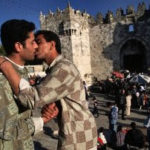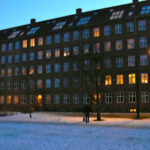A couple of weeks in the Mediterranean twin cities of Barcelona and Sitges is enough to see this destination as one of the prime LGBT places to visit or live. This journalist was easily convinced of the sites and insights for a good life here.
By Richard Ammon
GlobalGayz.com
April 2013
Of course it’s impossible to say anything is the ‘best’ thing in this complex and multi-layered world but I will ignore that issue and claim that the twin cities Barcelona and Sitges offer LGBT denizens of this partied-out and discriminated world one of the most desirable areas to live.
This selection is based on several criteria of lifestyle measurements that include: 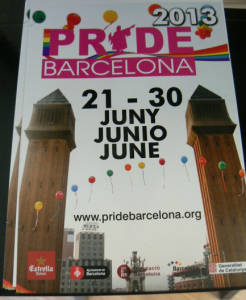
1 gay marriage
2 LGBT rights and protections
3 Pride visibility
4 city location and appearance
5 climate
6 LGBT district
Let’s start with an opinion poll of which there are many; I picked this one from the British newspaper ‘The Independent’. In no particular order this poll produced, arguably, a list of the ten most desirable ‘gay cities’ as follows: San Francisco, New York City, Mykonos, Greece, Sydney, Paris, Barcelona/Sitges, Amsterdam, London, Copenhagen and Berlin.
In several ways all these cities are very similar, especially when measured by the social life. Each of these locations has dozens to hundreds of familiar LGBT entertainments ranging from bars to churches to saunas to bookstores with back rooms to gay rights advocacy groups, cafes and hotels. In this regard they are virtually all equal, except for Mykonos which is not really in the same league. But never mind.
My choice for number one is Barcelona because it has certain distinctions that move it to the head of my list.
(1)
Gay Marriage
This is currently the ‘crown jewel’ of the gay rights movement in the civilized world. It is not just a cause celebre´ but is a crucial defining symbol of humanity’s best civility for treating all people equally.
Same-sex marriage in Spain has been legal since 2005 after the Social Democratic-led government, headed by Prime Minister José Zapatero, pressed for its legalization, including the right of child adoption. After the usual fierce, emotional and often irrational debate, a statute allowing same-sex marriage was approved by the Spanish parliament on 30 June 2005 and publicized on 2 July 2005. The law took effect the next day which made Spain the third country in the world to allow such marriages. (Netherlands and Belgium were first and second). Canada followed with their legal approval about two weeks later. Haltingly yet irreversibly modern civilization had begun to turn a corner in the long recovery of human sexuality from the clutches of dark religious dogma and unjust political prudery. It was no small achievement in Spain since the country was one of the strongholds of the Catholic church with its vehement anti-gay attitudes.
Being an emotional and political symbol of equality, and only a symbol not a compulsion, most LGBT couples do not choose the option of marriage for various reasons including an interpretation of marriage as a heterosexist artifice sourced historically in the concept of power and possession, usually of a man over woman. Most gay couples reject that imbalance and opt for an egalitarian relationship based on intimacy, respect, communication, shared responsibility and open-mindedness–within marriage or without. Legal bonds are easily created by contracts, wills, trusts and other judicial documents.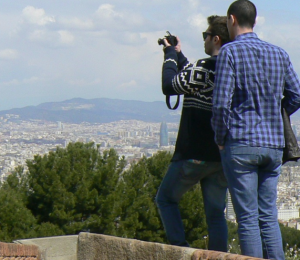
Whatever considerations or reactions LGBT couples have to marriage, the major point here is that this ritual is very present in Spain as it is in only eleven other countries (out of 206 worldwide). As of 2013 the countries with legalized gay marriage are: Argentina. Belgium, Canada, Denmark, Iceland, Netherlands, Norway, Portugal, South Africa, Spain, Sweden and Uruguay (approved in April 2013)–and as I post this story New Zealand is legislating legal gay marriage as well. A happy 13th country.
For purposes of this commentary, it’s notable that six out of ten of the cities in the ‘most desirable’ LGBT poll are in countries that have not approved same-sex marriage: this eliminates New York, San Francisco, London, Paris, Mykonos, Sydney and Berlin from my priority list. However, in these countries the marriage issue is a very hot topic that will doubtless result in more marriage-approved countries within the next three years.
(2)
Gay Rights and Protections
As part of the gay marriage ‘package’ that is accepted in these countries there are commonly other rights and protections that are affiliated with it. In Spain, same-sex couples can adopt children as a couple. as well, a law permits transgender individuals to register under their preferred gender in public documents even without having surgical procedures. Another Spanish law on assisted reproduction was also amended in 2006: children born within a lesbian marriage from ‘in-vitro’ fertilization can be legally and equally assumed as legal offspring by both women regardless who is the birthing or the non-biological mother.
It is reported that soon after the same-sex marriage was approved, a member of the Guardia Civil, a military-police force, married his lifelong partner. This prompted the highly macho organization to permit same-sex partners to cohabitate in the force’s designated quarters, becoming the first military force in Europe to house same-sex partners on a military installation.
A summary of these Spanish LGBT rights is listed here:
same-sex marriage; legality of same-sex sexual activity and recognition of same-sex couples (married or not); equal age of consent; national anti-discrimination laws in employment and provision of goods and services; hate speech is forbidden; both joint and step adoption by same-sex couples is permitted; gays can serve openly in the military; all have the right to change their legal gender; there is equal access to IVF and surrogacy for all couples and individuals; gay men are allowed to donate blood.
(3)
Gay Pride (visibility of the scene)
2013 will be the fifth year for BCN Pride. During this time, Barcelona’s Gay Pride has become very visible and now has its own bright and colorful storefront office in Eixample on a main avenue among numerous other gay and non-gay business venues. Pride Barcelona ’13 will host the main celebrations for three days on the last weekend in June, preceded by ten days of festival programs–culture, sport, debate, entertainment and parties.
Thirty charitable associations, dozens of local businesses and organizations from the LBGT community unite to organize this annual celebration for the city. “Pride Barcelona is a major free not-for-profit event that both celebrates the best of the Catalan capital,” claims their website. “Spain is a shining example of LGBT Rights that daily reaffirms an open, respectful and tolerant character with Barcelona clearly in the lead.”
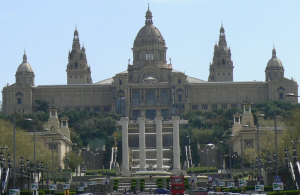 During Pride week a ‘village’ emerges in the big plaza in front of the steps to the magnificent Catalunya National Gallery of Art (photo left) on Avenida Maria Christina. Dozens of white tent stalls are hosted by gay and gay-supportive businesses in the city and beyond. This is capped by big streets parties on the last two days of Pride weekend when the circus of the Pride Parade arrives in full bloom in the Plaza Espana. What Barcelona’s Pride lacks in size (a mere 200-300 thousand participants and attendees compared to Sao Paolo’s 2 million) it makes up for in color, Catalunyan attitude and exuberance.
During Pride week a ‘village’ emerges in the big plaza in front of the steps to the magnificent Catalunya National Gallery of Art (photo left) on Avenida Maria Christina. Dozens of white tent stalls are hosted by gay and gay-supportive businesses in the city and beyond. This is capped by big streets parties on the last two days of Pride weekend when the circus of the Pride Parade arrives in full bloom in the Plaza Espana. What Barcelona’s Pride lacks in size (a mere 200-300 thousand participants and attendees compared to Sao Paolo’s 2 million) it makes up for in color, Catalunyan attitude and exuberance.
Barcelona is the second-largest city in Spain. In addition to its proud LGBT citizens, many gay-friendly elders sit around on park benches with cronies playing chess; skaters and bikers make their acrobatic moves in the streets and curbs; trendy shoppers strut along in designer brands heels and of course the unavoidable hoards of tourists in jeans and khakis. During Easter Holy Week there are religious processions with heavily decorated floats of life-size religious scenes that are carried through the streets by dozens of hooded ‘penitents’. Among the thousands of people along the procession routes can be seen LGBT couples, some with pet dogs, some with baby carriages. I saw an occasional two-some holding hands and once two guys exchanged a brief kiss without blinking; there does not appear to be a need to show personal gay pride in public behavior since the Spanish gay community feels secure in its well established rights and privileges.
(4)
Location and Appearance
Barcelona is on the western edge of the Mediterranean which provides beaches, beautiful sea views, an international seaport and easy access to the Balearic Islands and other former territories of the Roman Empire around the wide Sea. The city’s prime location makes it one the major desirable metropolises of western civilization, with Paris, Rome, Madrid and Berlin less than two hours flying time away to the east and north; in Africa, the ancient cities of Cairo, Casablanca, Tunis and the exotic Sahara are even closer.
It is easily one of the most beautiful cities in Europe with eight hundred years of architectural styles to admire, from Byzantine to Moderista, baroque to art nouveau. Wide boulevards, broad 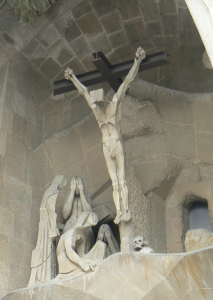 parks, expansive plazas with fountains and sculpture abound. Charming narrow old-town alleys are lined with countless small outdoor cafes set among gothic churches, museums, art galleries and the enormous 15th century gothic cathedral. Vastly popular is the tortured beauty of numerous Antoni Gaudi architectural creations, epitomized by the towering steeples of the enormous Sagrada Familia church, itself the size of a cathedral, that’s visited by eight thousand people a day. (photo right, detail of sculpture)
parks, expansive plazas with fountains and sculpture abound. Charming narrow old-town alleys are lined with countless small outdoor cafes set among gothic churches, museums, art galleries and the enormous 15th century gothic cathedral. Vastly popular is the tortured beauty of numerous Antoni Gaudi architectural creations, epitomized by the towering steeples of the enormous Sagrada Familia church, itself the size of a cathedral, that’s visited by eight thousand people a day. (photo right, detail of sculpture)
The Catalunya National Gallery of Art is the size of an imperial palace and overlooks the city from above a thunderous water cascade. The famous Ramblas is a delightful wide boulevard of trees, cafes and restaurants, shops, theaters, more churches, with a central pedestrian promenade that cuts energetically through the city for over a kilometer from the port to the old town. The avenue is vibrant, cheerful, entertaining and beautiful. Architectural wonders are not just limited to the outstanding masterworks but can be seen in thousands of low-rise (7-10 stories) apartment buildings with decorative facades and ornamental balconies along tree lined streets.
On the Montjuic hill overlooking the port and the city are some of the futuristic-looking sports 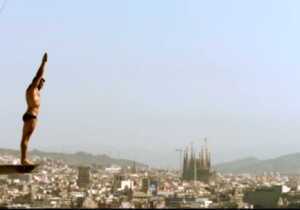 facilities used for the 1992 Olympics. Of special interest to me is the huge aquatic center (photo left, diver) with its three pools that are still used today as the city’s premier swimming venue. Indeed, Barcelona has two scenic ‘mountains’ within its city limits that are both crowned with magnificent buildings. On Montjuic is a gigantic muscular military fortress from the 18th century; on the crown of Tibidabo mountain is a beautiful 20th century Catholic church topped by a thirty-foot statue of Christ similar to the impressive mountain Christus statue in Rio de Janeiro.
facilities used for the 1992 Olympics. Of special interest to me is the huge aquatic center (photo left, diver) with its three pools that are still used today as the city’s premier swimming venue. Indeed, Barcelona has two scenic ‘mountains’ within its city limits that are both crowned with magnificent buildings. On Montjuic is a gigantic muscular military fortress from the 18th century; on the crown of Tibidabo mountain is a beautiful 20th century Catholic church topped by a thirty-foot statue of Christ similar to the impressive mountain Christus statue in Rio de Janeiro.
From small wrought iron ornamental water fountains on back streets in the old gothic quarter to the giant palatial buildings with spectacular panoramic vistas, Barcelona is a cornucopia of sights and delights.
(5)
Climate
An important influence on the mood, sociability and ambiance of gay life in Barcelona is the weather. The positive effect results from the city’s southern European location on the Mediterranean which moderates the temperature year round. Even in the coldest months, the average temperature in this area of Spain is 13-15C (55-59F) which is still outdoor cafe weather on sunny days. This crucial factor moves the city’s listing ahead of other cities with high gay populations: New York City, San Francisco, Copenhagen, Reykjavik, Amsterdam, Oslo, Stockholm as well as Canadian ‘gay cities’ where temperatures fall below or close to freezing for a good portion of the year. Barcelona is passably mild during the four coldest months. Flowers bloom earlier and cafe hours expand with longer days. Outdoor life continues year round as Spaniards love to talk to each other over tiny cups of cappuccino.
In the southern hemisphere, favorite gay places such as Capetown (winter temps 49-60F; 9-16C), Buenos Aires (59-62F; 15-17C) and Sydney (62-67F; 17-20C) are generally as mild as Barcelona. As well, two countries–South Africa and Argentina–offer similar legal protections and equal marriage. However, South Africa’s liberal constitution does not soak deeply into the culture and homophobia is very high outside the city centers. A favorite and deadly belief among many straight young men is that the cure for lesbianism is rape. Such violent anti-lesbian behavior is unheard of in Spain.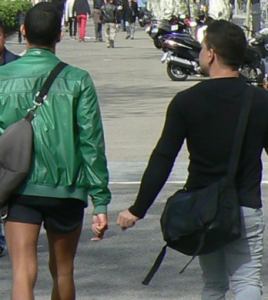
This leaves Buenos Aires (although not on the poll list) as a progressive gay destination with marriage rights and a moderate climate. Oddly however, Argentina does not yet offer comprehensive equality and anti-discrimination laws in employment and the provision of goods and services. Another factor that keeps Buenos Aires from topping my list is its location many miles from other major LGBT hubs.
The closest matching gayborhoods are next door in Brazil, Rio and Sao Paulo, more than a thousand miles away, which strangely also did not get voted into the ‘ten best’ list. The Argentine city also lacks the wide diversity of architectural styles and fabulous beaches of Barcelona/Sitges. Dampening the liberal attitudes there is the homophobic latino machismo that’s still strong among the majority of South America. This is contrasted with a 2006 survey revealed that 66 percent of Spanish citizens actively or passively support same-sex marriage.
Another close runner-up city is Sydney but this appealing city is currently a Jekyll-and Hyde place regarding homosexuality. It hosts of one the world’s largest gay festivals, Mardi Gras, and has large LGBT neighborhoods yet politicians in the conservative government refuse to allow gay marriage to be debated. But as in the USA, individual states have progressed more than the federal government toward LGBT protections and rights. There is a widespread sense of freedom for gay life in the major cities, which all have their own Pride festivals without being inhibited by the federal governments disregard of social equality.
(6)
The District
All of the popular LGBT destination cities have a similar abundance of social venues–bars, clubs, restaurants, hotels, saunas, cafes, shops, organizations but such places are not what separates or ranks them. LGBT life in Barcelona is mostly centered in the district of Eixample which presents the essence, color and vibrancy of this city of privilege for LGBT citizens.
Eixample is where the social scene is well situated in a trendy, upper middle class milieu of fashionable clothiers, gourmet and informal restaurants, corner cafes, architectural pleasures of diverse styles and colorful LGBT storefront organizations such as COGAM (national rights), Barcelona Pride and Panteres Grogues (sports club). Walking street sweepers in clean green uniforms keep the area tidy; the sidewalks are wide; upscale and mid-scale cars are parked neatly along the avenues which are geometrically laid out in grid. It’s easy to find one’s way around.
Architecture: central Barcelona has hundreds upon hundreds (thousands!) of period buildings, from ultra-modern to gothic and from ancient Roman to art deco, including a few with bizarre and beautiful Antoni Gaudi designs. (Places like NYC have stylish and innovative structures but also thousands of bland or ugly buildings, street after street.) Eixample’s five to ten story residential buildings, street after street, have distinctive and decorative facades of color, ornamentation and wrought iron balcony railings.
The area is tree-lined and quiet and gentrified in the day and gets busy with LGBT venue hoppers starting no earlier than ten at night. Some restaurants do not open for dinner until nine, such as the Bench restaurant in the very gay art deco style Axel Hotel that’s the unofficial flagship of the district. Throughout Eixample, and some beyond, are bars and clubs and shops that clearly define this as the gay ‘ghetto’, although it is hardly that. It’s more like a manicured metropolis of stylish and trendy lifestyles.
Periodicals: free for the taking from any shop in the area, anyone can find the LGBT mainstays of periodicals: GB men’s lifestyle magazine, NOIS events and venue magazine, Shanguide to gay BCN, FunGanga LGBT leisure guide, InfoGay magazine of culture, opinion and activism, as well as free gay maps (including Sitges). Just a quick look at these publications reveals listings for hundreds of day and night spots for the gay and gay-friendly community in both cities.
The Gay map–or maps–warrant special notice here. There are two gay maps (maybe more, but I saw only two) published by different companies. The smaller one is put out by the magazine ‘NOIS’, a lifestyle-event-fashion-eros-commentary monthly glossy rag targeted to the LGBT community in Barcelona. On two sides it has a large city map and a smaller gay ‘ghetto’ district map surrounded by a couple of dozen ads for bars, restaurants, hotels and saunas. A much larger map (and a separate one for Stiges) is nearly two feet square and produced by Urbanloop publisher. 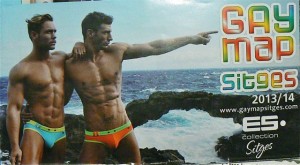
Surrounding this map–also two-sided of the larger city and the gay district–are more than four dozen ads similar to the Nois map in variety. Also on this map there appears a comprehensive listing of more than a hundred services and venues catering to the LGBT community: eight separate specialty organizations (including the ACEGAL human rights group), about twenty bars and the same number of fashion boutiques, seven saunas, a dozen health and fitness places. Not listed are the gay-friendly cafes which number in the hundreds throughout this city of 1.7 million people. These highly informative maps are essential for first time gay/lesbian visitors and are impressive evidence of the wide extent of LGBT life in Barcelona.
A Personal View
It’s easy to talk about a city in a general descriptive manner. For a small window into personal gay life in Barcelona, I met up with a new acquaintance one sunny afternoon in the central university area. Mous (short for Moustafel) is half Spanish and half Moroccan who works in the I.T. tech industry. He was raised in Holland where his mother lived for many years but frequently visited her family in Madrid. As a result he speaks Dutch, Spanish, English and Arabic, the latter learned from this father’s side of the family.
Mous went to university in Holland to learn computer analysis and is now an independent consultant for international companies. I asked him to reflect on gay life in Barcelona and how it contrasts with the famous gayborhoods of Amsterdam.
“Barcelona gays are the same as and yet different,” said Mous. They are similar in their lifestyle of friendship, socializing, organizing, coupling, types of gay venues, freedoms and rights, Pride feasts and of course freedom to marry (in Holland).
“One of the noticeable differences for me is their eagerness for sex without the ‘games’ of foreplay, that is, talking and developing some familiarity–especially with a new person who might become a relationship. In Holland we usually date for a couple or several times but here dating usually begins in bed the first night. It seems men here need to establish basic roles and preferences as soon as possiible”.
“Bed chat, physical non-sex intimacy and interpersonal familiarity come later,” at least compared to the ‘northern gay style’ where he grew up. “Guys are less protective here and will go for the bed before they go for the heart. That also goes for safe-sex; guys here tend to prefer barebacking, which I am not used to. especially before I get know someone better. Guys here are more ready to jump into bed before any niceties are exchanged or coffee is served.”
At first this was disconcerting for Mous but after two years of full time living in the ‘south’ and acclimating to the mild climate he is more relaxed with the local styles.
One of the upside effects of local’s ‘over-eagerness’ is that Catalunyan gay men don’t make a distinction if a ‘hot guy’ is not from Catalunya (northeast Spain). “When it comes to sex or love there is no discrimination. The big difference is in the language which tends to separate Catalunya Barcelona from Castilian ‘mainland’ Spain. There is a long tradition of Catalunya declaring themselves distinct–indeed, independent– from the rest of Spain. When the people in BCN gather for coffee or a drink they speak Catalan which leaves Spanish-only-speaking friends or boyfriends out of the conversation.
Another important factor in feeling one’s way into an LGBT circle in Spain is the very common habit of smoking cigarettes. I have no statistics but it appears that 75% of Spaniards have nicotine addiction. This is not a problem among smokers but for non-smoker it is a divisive issue and can inhibit the development of sexual intimacy. At restaurants, where smoking is not allowed inside, a non-smoker can smell the residual odor in clothing when a smoker is nearby. It is an odd sight for this California writer to see a buff and healthy person emerge from a gym after a workout and light up!
Summary
As a result of these opinionated factors, Barcelona for me emerges as the leader for GLBT life, sites and insights. With charming and stylish neighborhoods rife with gay nightlife, fashionable shopping, hip boutique hotels, exceptional restaurants and highly effective gay rights organizations plus some of the world’s most popular gay beaches, this metropolis area stands above most others. As mentioned before, what also puts Barcelona ahead in this survey of ‘paradise places’ is its satellite charming beachside town of Sitges, easily one of Spain’s most desirable gay resorts with its wonderland expanses of white sandy beaches along azure blue waters that’s packed in the warm months with bodies, towels and wandering eyes that understand how privileged and beautiful gay life can be–should be globally.
Barcelona/Sitges is my winner.

